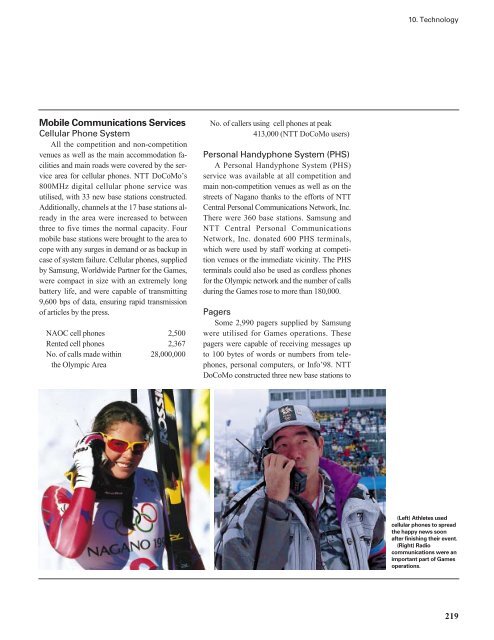107th IOC Session - LA84 Foundation
107th IOC Session - LA84 Foundation
107th IOC Session - LA84 Foundation
You also want an ePaper? Increase the reach of your titles
YUMPU automatically turns print PDFs into web optimized ePapers that Google loves.
Mobile Communications Services<br />
Cellular Phone System<br />
All the competition and non-competition<br />
venues as well as the main accommodation facilities<br />
and main roads were covered by the service<br />
area for cellular phones. NTT DoCoMo’s<br />
800MHz digital cellular phone service was<br />
utilised, with 33 new base stations constructed.<br />
Additionally, channels at the 17 base stations already<br />
in the area were increased to between<br />
three to five times the normal capacity. Four<br />
mobile base stations were brought to the area to<br />
cope with any surges in demand or as backup in<br />
case of system failure. Cellular phones, supplied<br />
by Samsung, Worldwide Partner for the Games,<br />
were compact in size with an extremely long<br />
battery life, and were capable of transmitting<br />
9,600 bps of data, ensuring rapid transmission<br />
of articles by the press.<br />
NAOC cell phones 2,500<br />
Rented cell phones 2,367<br />
No. of calls made within 28,000,000<br />
the Olympic Area<br />
No. of callers using cell phones at peak<br />
413,000 (NTT DoCoMo users)<br />
Personal Handyphone System (PHS)<br />
A Personal Handyphone System (PHS)<br />
service was available at all competition and<br />
main non-competition venues as well as on the<br />
streets of Nagano thanks to the efforts of NTT<br />
Central Personal Communications Network, Inc.<br />
There were 360 base stations. Samsung and<br />
NTT Central Personal Communications<br />
Network, Inc. donated 600 PHS terminals,<br />
which were used by staff working at competition<br />
venues or the immediate vicinity. The PHS<br />
terminals could also be used as cordless phones<br />
for the Olympic network and the number of calls<br />
during the Games rose to more than 180,000.<br />
Pagers<br />
Some 2,990 pagers supplied by Samsung<br />
were utilised for Games operations. These<br />
pagers were capable of receiving messages up<br />
to 100 bytes of words or numbers from telephones,<br />
personal computers, or Info’98. NTT<br />
DoCoMo constructed three new base stations to<br />
10. Technology<br />
(Left) Athletes used<br />
cellular phones to spread<br />
the happy news soon<br />
after finishing their event.<br />
(Right) Radio<br />
communications were an<br />
important part of Games<br />
operations.<br />
219
















